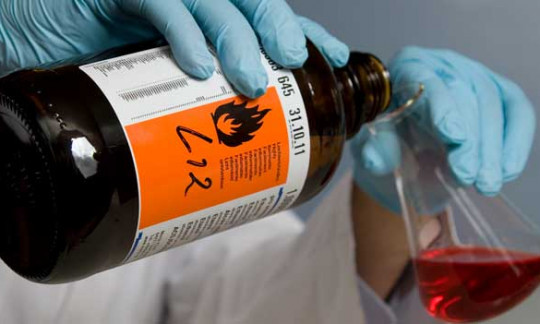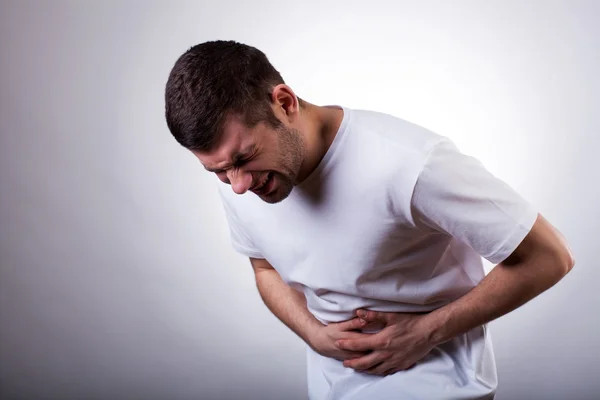Definition
Corrosive lesions of the esophagus result from the ingestion of strong acids or bases, leading to significant poisoning. This ingestion can be either intentional or accidental. Approximately 80% of cases occur in children under the age of 5, often due to accidental exposure or curiosity. A common cause in these instances is the ingestion of household cleaning solutions. Besides children, young adults over the age of 21 also frequently experience this type of poisoning. The ingestion of such hazardous substances can cause long-term damage to the digestive tract.
Causes
Corrosive lesions in the esophagus and throat are generally caused by the ingestion of strong acids or bases. Acids are considered strong if they have a pH below 2, while bases are considered strong if they have a pH above 12. Examples of strong acids include toilet cleaning fluids, battery fluids, rust removers, metal cleaners, cement cleaners, drain cleaners, and soldering fluids containing zinc chloride. Examples of strong bases include drain cleaners, products containing ammonia, oven cleaners, swimming pool cleaners, car cleaning detergents, hair relaxers, reagent tablets or ingredients used for reactions in urine or feces tests, bleach, and cement.
These substances typically cause more significant injury to the esophagus and stomach, as they tend to remain in these areas longer than in other parts of the digestive tract. However, lesions or sores can also occur in other areas that come into contact with the corrosive agent, such as the oral cavity, throat, upper respiratory tract, and small intestine.
Even though they are both corrosive, strong acids and strong bases have different effects on the digestive tract. Strong bases are generally colorless, tasteless, thicker, and do not have a very strong odor, so the amount of ingestion is often much greater than acids. When swallowed, strong bases react with proteins and fats in tissue which are then converted into protein-digesting enzymes and "soap", which is a mixture of fats and alkaline substances with a pH close to 7. These protein-digesting enzymes can cause further damage to tissue.
Meanwhile, strong acids generally smell and taste unpleasant, so they are often consumed in smaller quantities, and are usually swallowed immediately after entering the mouth. Strong acids that react with tissue will produce proteins that are acidic and clot. This clotting prevents further tissue damage, so the lesions are usually lighter than lesions caused by strong bases.
Risk factor
Corrosive lesions in the esophagus typically affect two main age groups: children under 5 years old and teenagers to young adults, particularly those aged 21 and over. In children under 5, ingestion usually occurs accidentally or out of curiosity. The severity in this age group is often lower because children tend to vomit the swallowed substance. In contrast, in adolescents and young adults, most cases are related to suicide attempts, resulting in greater quantities ingested and more severe lesions.
Symptoms
Symptoms that often appear after swallowing strong acids or bases are shortness of breath, hoarseness, difficulty swallowing, pain in the oral cavity, painful swallowing, chest pain, stomach pain, and nausea and vomiting. Difficulty swallowing initially occurs due to decreased movement of the esophagus, while if it occurs long after swallowing, it is due to changes in tissue into scar tissue, whether with narrowing of the esophagus or not. Pain can occur due to various things, for example due to a hole in the esophagus.
This pain really depends on which part of the esophagus is affected. If the upper esophagus is affected, the pain usually occurs in the neck and is accompanied by neck stiffness. Meanwhile, if the lower esophagus is affected, pain can be felt in the middle of the chest to the middle of the upper abdomen. This perforation can also occur due to violent vomiting or vomiting blood after swallowing a substance, causing severe chest pain.
Diagnosis
Corrosive lesions of the esophagus are a medical emergency. The initial examination focuses on assessing the patient's stability by checking vital signs such as blood pressure, body temperature, pulse, breathing rate, light reflexes in the eyes, and level of consciousness. Additionally, signs of respiratory distress, such as abnormal breath sounds and hoarseness, are evaluated. Symptoms indicating sores in the oral cavity and throat include drooling, refusal to eat, and difficulty swallowing. Severe lesions can lead to shock or systemic circulatory failure. If the esophagus is perforated, air may collect under the skin near the neck or chest. Health workers will also strive to identify the type of substance ingested as soon as possible.
Laboratory tests that can be carried out are acidity tests to determine the pH of swallowed substances and the pH of saliva. Complete blood tests, blood electrolytes, kidney function tests and blood gas analysis can be done to look for poisoning that has spread throughout the body. Liver function and blood clotting tests can be carried out to determine the presence of blood clotting disorders. Urinary examination can be done to guide fluid replacement. Blood type checks and compatibility with donor blood can be carried out for patients who will undergo surgery or who have a high risk of gastrointestinal bleeding. An electrical examination of the heart can also be carried out if it is suspected that the motive for swallowing is to end life. Blood calcium examination is also necessary, especially if poisoning occurs due to hydrofluoric acid, because it can decrease drastically and cause heart rhythm disturbances.
Imaging examinations are very important to do. The initial examination can include an X-ray of the chest and abdomen to look for possible holes in the esophagus, reactions in the airways and lungs, as well as swallowed foreign objects such as button batteries. A computed tomography scan (CT scan) can show how much tissue is affected by ingestion of the substance. If health facilities are adequate, endoscopy can be performed by inserting a tube with a camera at the end into the mouth, esophagus, stomach and small intestine. Endoscopy can be used to determine the severity of the lesion, but it is recommended to do it before the 4th day because the cells are undergoing the healing process.
Management
If you suspect or know that someone has ingested a corrosive substance, there are several actions you can take before reaching the nearest health facility:
- Identify the substance ingested
- Do not induce vomiting in the victim
- Do not give anti-emetic medication to the victim
- Do not attempt to neutralize the pH using weak acids or bases
- Use water (if the substance is alkaline) or milk (if the substance is acidic) to neutralize the pH quickly in small amounts. If the substance is unknown, it is better not to give anything
This condition is an emergency condition, so initial management in the ER will aim to stabilize the patient's condition, namely by ensuring the airway is open and safe (airway), breathing is stable without negative stress (breathing), and blood circulation is stable (circulation). Anesthesia may be used during this procedure. Insertion of a feeding tube can be done to suck out the causative substance if done immediately after swallowing. Once the patient's condition is stable, the patient can be planned for hospitalization and further monitoring. Antibiotics will be given to prevent infection because digestive tract cells are unable to protect themselves from bacteria in this condition. Surgery can also be performed after 3 weeks if there is narrowing of the esophagus.
Complications
Complications of corrosive lesions of the esophagus can occur in the short and long term. Short-term complications can include a hole in the esophagus or stomach and death. Perforation can occur in the initial phase after ingestion of the substance until 2-3 weeks later. Meanwhile, long-term complications can include narrowing of the digestive tract and the conversion of digestive tract cells into cancer cells. Narrowing of the digestive tract can occur in either the esophagus or stomach, which can appear as complaints of difficulty swallowing, nausea and vomiting after eating, and drastic weight loss. The possibility of someone experiencing malignant cancer of the gastrointestinal tract after swallowing corrosive substances increases 1,000-3,000 times. Therefore, routine examination with endoscopy is recommended approximately 20 years after swallowing occurs, with an interval of 1-3 years.
Prevention
Substances can be prevented from corrosive lesions by being kept in their original packaging with clear hazard labels and out of the reach of children. In the workplace, it is crucial to implement and adhere to strict operational policies and standards to ensure that any exposure is handled quickly and effectively.
When to see a doctor?
Seek medical attention if someone around you, including your child or yourself, has inadvertently ingested a potentially corrosive chemical. If you are unsure about the ingestion, refer to the symptom list provided earlier to be aware of any signs of corrosive substance ingestion, particularly if the ingestion occurred suddenly. The quicker the victim is brought to a healthcare facility, the higher the chances of ensuring their safety without severe complications.
Looking for more information about other diseases? Click here!
- dr Hanifa Rahma
Elkaramany, M. (2018). An overview of corrosive injury of the upper gastrointestinal tract: Discussion of types, clinical evaluation, and management procedures. Advances In Digestive Medicine, 5(4), 115-120. doi: 10.1002/aid2.13091
Lung, D. (2020). Caustic Ingestions: Practice Essentials, Pathophysiology, Etiology. Retrieved 4 January 2022, from https://emedicine.medscape.com/article/813772-overview#a1
Lusong, M., Timbol, A., & Tuazon, D. (2017). Management of esophageal caustic injury. World Journal Of Gastrointestinal Pharmacology And Therapeutics, 8(2), 90. doi: 10.4292/wjgpt.v8.i2.90











